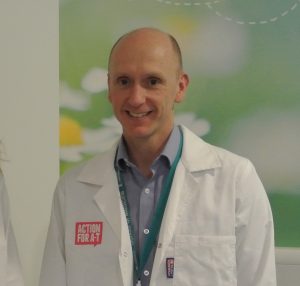Biomarkers for Babies and Young Children with Ataxia Telangiectasia (BOBCAT)
Principal researcher: Professor Rob Dineen
Institute: University of Nottingham, UK
Cost: £246,867.32 over 60 months in partnership with The A-T Society (UK) AEFAT (Spain) and BrAshA-T (Australia)
Start Date: 1st of September 2024
What are the researchers proposing to do?
In 2021 the UK Neonatal Bloodspot Screening programme (the ‘heel-prick test’ that new-born babies have) included a new test to pick up severe immune system problems, and as a result some babies with A-T have been identified. For the first time, this gives us the opportunity to collect measures (from brain and lung scans, blood samples and videos of movements) from babies and very young children with A-T before they have any symptoms, and as they grow. The team at Nottingham will take these measurements yearly over 4 years. This will provide unique data on how the organ measurements change in the earliest stages of A-T from before symptoms are present.
Why?
New treatments are being developed for ataxia telangiectasia (A-T) that aim to reduce the disability that typically develops during childhood. For these treatments to be most effective it is likely that they will need to be started very early in childhood. Currently clinicians don’t know how measurements of damage to organs in A-T, particularly the brain and lungs, change during very early childhood meaning we don’t know which measurement will be useful for monitoring the effects of new treatments in babies and very young children with A-T.
How will the research be done?
Professor Dineen and his team will recruit families whose babies are found to have A-T following the new-born heel-prick test plus families whose baby receives an A-T diagnosis because an older sibling had already been diagnosed with A-T. These families will attend various sessions at the Nottingham A-T clinic during which the baby will have an MRI scan of the brain and lungs, recordings of eye and limb movements, and a blood test. The families will bring their children for the assessments annually, so that changes can be observed as the child grows and as they start to show the features of A-T. The research team will then compare these measures to those from infants and children without A-T.
How could it make a difference in the lives of those affected by A-T?
Even in clinical trials of powerful treatments, it may take several years for effects of treatments on disability to become obvious. This means clinical trials may have to be long duration (and therefore more costly), which could stifle clinical research of new treatments. Researchers would find it very valuable to have sensitive measures (referred to as ‘biomarkers’) of disease progression that could allow researchers to detect an early benefit of a new treatment before effects of the treatment on disability become obvious. Showing an early benefit of a treatment by detecting a positive effect on a biomarker of A-T could allow researchers to select the best treatments to take forward into the longer full-scale clinical trials. However, at the moment we have no agreed biomarkers of A-T disease progression in infants and very young children with A-T, who are the ones who may benefit most from new treatments aiming to reduce lifelong disability in A-T.
This project will not provide immediate benefit for the participating individuals but will hopefully help infants and young children diagnosed with A-T in the future who may be included in treatment trials from a very young age.
For further information about the BOBCAT study please contact the research team directly via BOBCAT@nottingham.ac.uk





